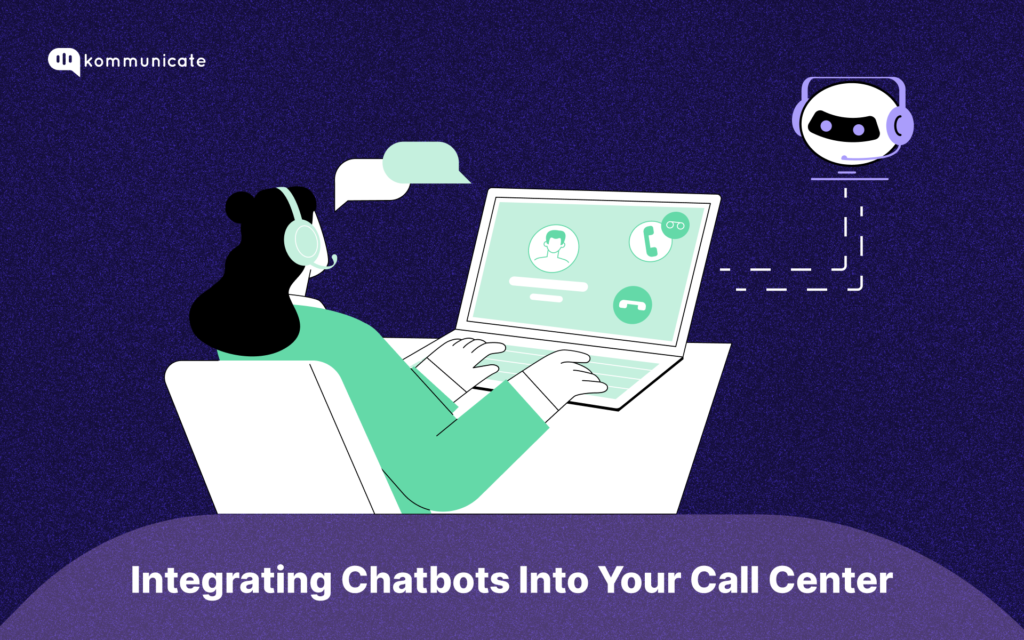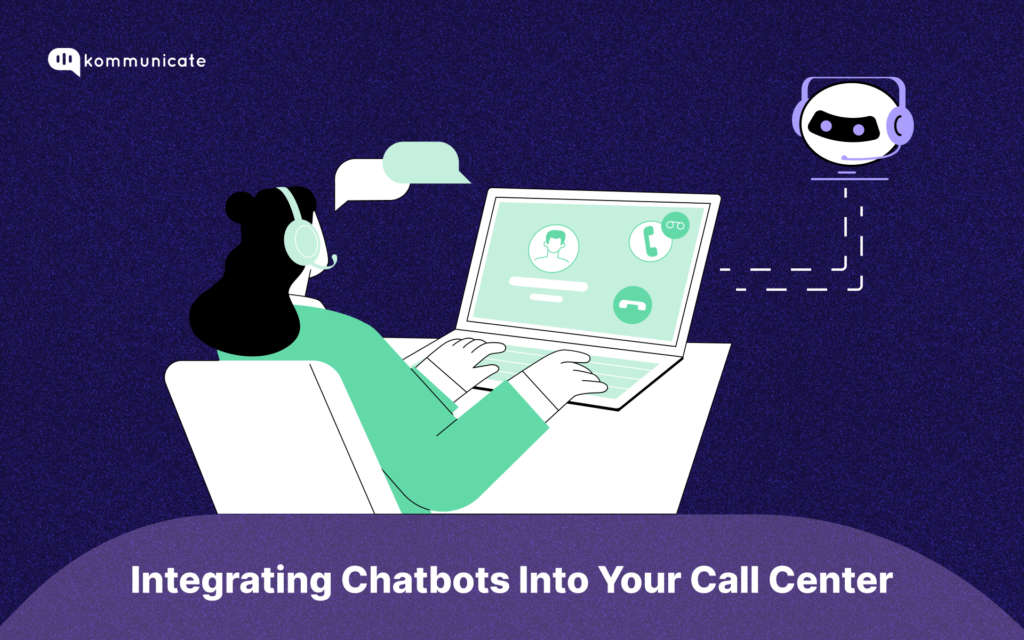
As a customer service leader, you know how important it is to provide the best service when someone interacts with your call center. One bad experience for a customer will have far flung implications. In an ideal world, all your call center agents are perfectly trained, and your customers are always happy with their interactions. But we don’t live in an ideal world and your call center agents may not always be available, and this is where a chatbot in call center comes in.
A Gartner study, in fact, predicts that by 2026, conversational AI solutions such as chatbots will reduce agent labor costs by as much as $80 billion.
But it is not as though call centers are going out of business.
As the graph shows, the number of call center employees in the US steadily increases yearly. As chatbots and AI agents automate repetitive tasks, these agents will encounter increasingly sophisticated problems.
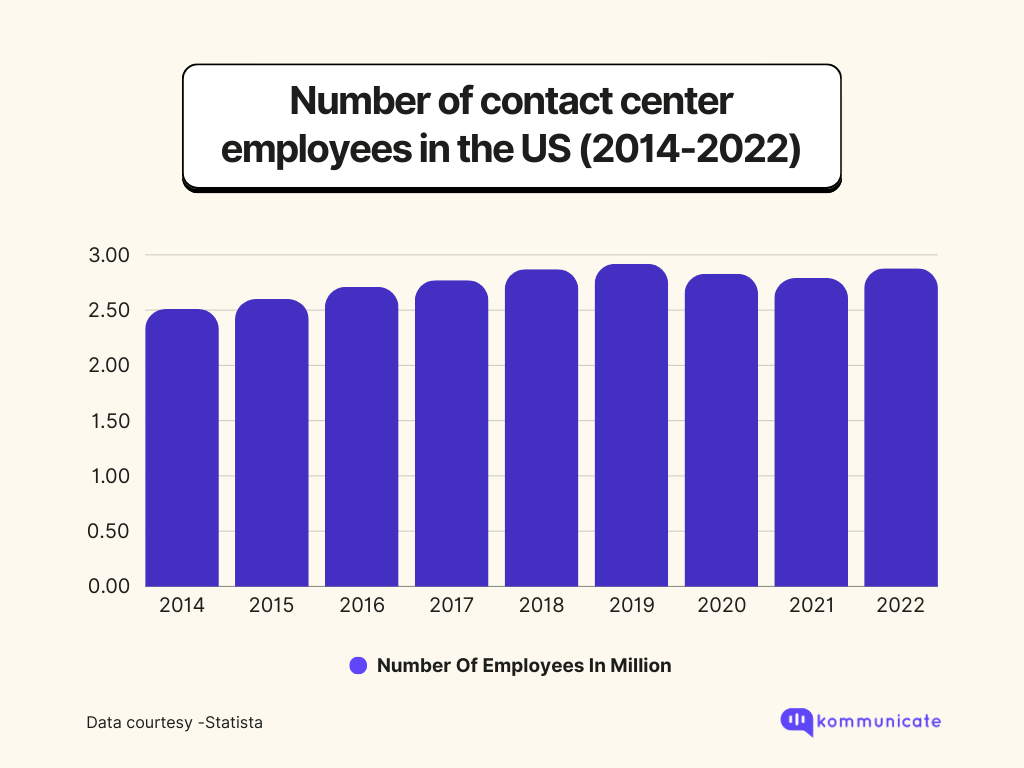
And chatbots can go beyond being available 24/7 to the customers and taking care of repetitive tasks.
Let us look at the 10 benefits of integrating a chatbot into your call center.
- Agent Coaching / Performance Enhancement
- Proactive Customer Engagement
- Sentiment Analysis
- Continuous Learning
- Seamless Omnichannel Integration
- Personalization in Self-Service
- Compliance and Quality Assurance
- Predictive Analytics
- Knowledge Sharing
- Multilingual Support
Let us begin this list with the very first reason: Agent coaching.
1. Agent Coaching / Performance Enhancement
Human agents often tend to get too technical with customers, unnecessarily using technical jargon and confusing them. On these occasions, a chatbot can provide the necessary course correction, giving real-time feedback and guidance to human agents.
It can also happen that an agent has handled a customer query exceptionally well, and chatbots can then suggest sharing it with the team as a best practice. Chabots can thus continuously monitor and analyze agent-customer exchanges, allowing them to offer tailored coaching to help improve their communication skills.
Agents can also improve their product knowledge and overall customer service skills by using this type of chatbot in a call center. Aavenir, an RPA Conversational AI platform, for instance, was used by Conduent, a business process services company, in its call center operations.
Agents at Conduent say that the chatbot has helped them make more effective communicators, improving their customer service skills and leading to higher customer satisfaction.
2. Proactive Customer Engagement
Chatbots can analyze behavior patterns, identify potential issues or opportunities, and then proactively contact customers before these problems escalate.
A proactive approach streamlines the customer journey, increases conversion rates, and improves overall customer satisfaction. Proactively reaching out to customers also goes a long way in preventing customer frustration.
A good example of a chatbot that engages in proactive engagement is HSBC’s chatbot AMI. If a customer has been browsing through the HSBC website’s mortgage section for an extended period of time, the chatbot reaches out to them. It then goes one step ahead and offers them personalized assistance, assisting them through the application process and answering any queries they have.
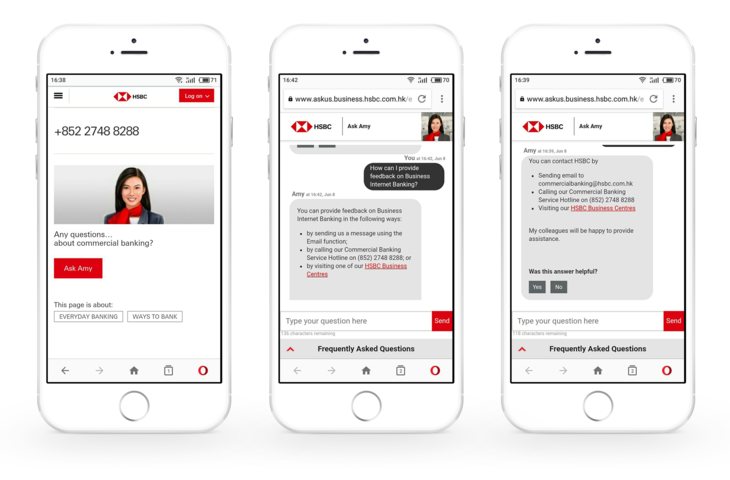
3. Sentiment Analysis
Sentiment analysis is a key function that is performed by chatbot in call center. By closely studying the emotional tone and language used by customers during interactions, advanced chatbots are able to detect frustration or anger in real time.
If a chatbot detects abnormality in the tone of the conversation, like frustration, then it can adjust its language, provide clearer explanations, or even do a human-handoff. Chatbots ensure that emotional intelligence is woven into every customer interaction, leading to an overall improved customer experience.
An example of a chatbot that is improving customer experience is Amelia, which is a conversational AI assistant that is in use by Swedbank. Amelia uses NLP and Sentiment analysis to understand the emotional state of customers.
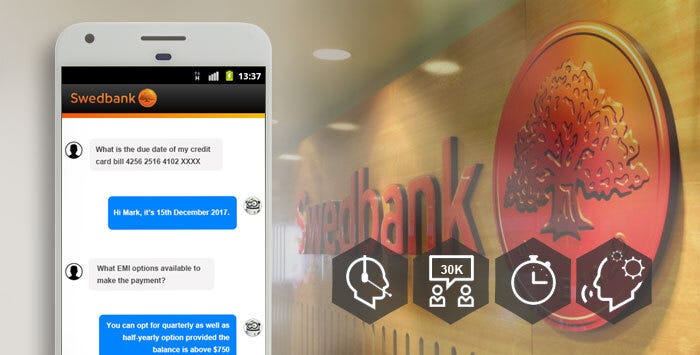
Amelia can detect subtle changes in tone, adopting her responses accordingly and bringing in a human agent when the need arises. Chatbots that can perform sentiment analysis are thus invaluable when it comes to improving overall customer satisfaction.
4. Continuous Learning
Ever heard of self-optimizing customer support systems? If not, then this is the next evolution of chatbots, which are continuously learning from past customer interactions and improving their performance.
Integrating a chatbot in call center offers significant benefits, including continuous learning and adaptation. Chatbots can continuously refine their knowledge base, thereby improving their natural language processing capabilities.
A great example of a real-life conversational AI chatbot that uses machine learning to improve its performance continuously is Amelia, which was developed by IPsoft. Amelia’s ML algorithms continuously learn from successful and unsuccessful customer interactions and identify areas of improvement and patterns in real-time.
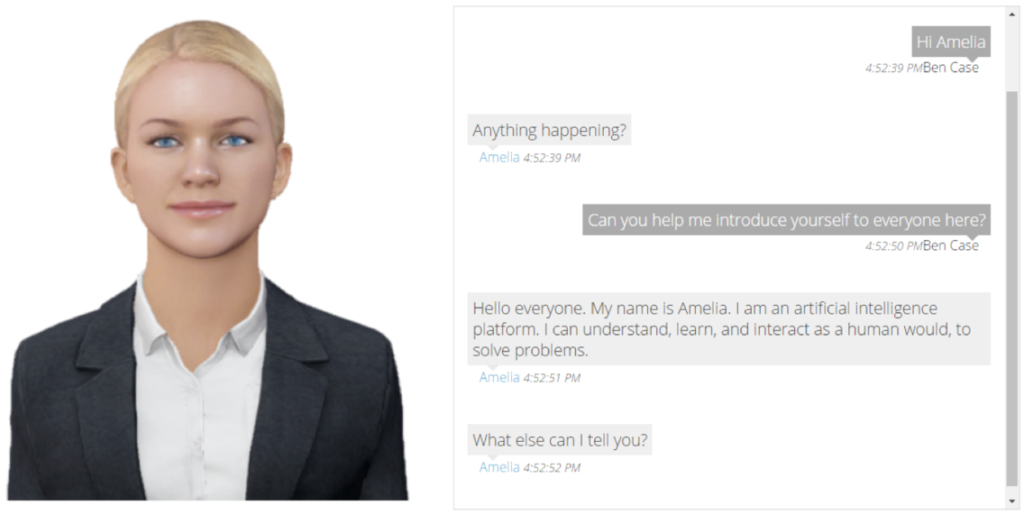
5. Seamless Omnichannel Integration
Customers are picky about the channels in which they want to interact with the business. Some of them want to talk to you over the phone, some want to send an email, while others prefer the ever-responsive chatbot.
As a business owner, you must ensure that the customers receive a unified and seamless experience across all platforms, and this is where a chatbot can excel in. You can deploy chatbots across multiple touch points, including websites, mobile apps, social media platforms, messaging services, etc. Regardless of the platform, the customers will get a consistent experience.
MasterCard’s AI-powered chatbot, which they have integrated into the company’s mobile app, Facebook Messenger and website. Customers can check their balance using the chatbot, initiate a transaction, or seek support.
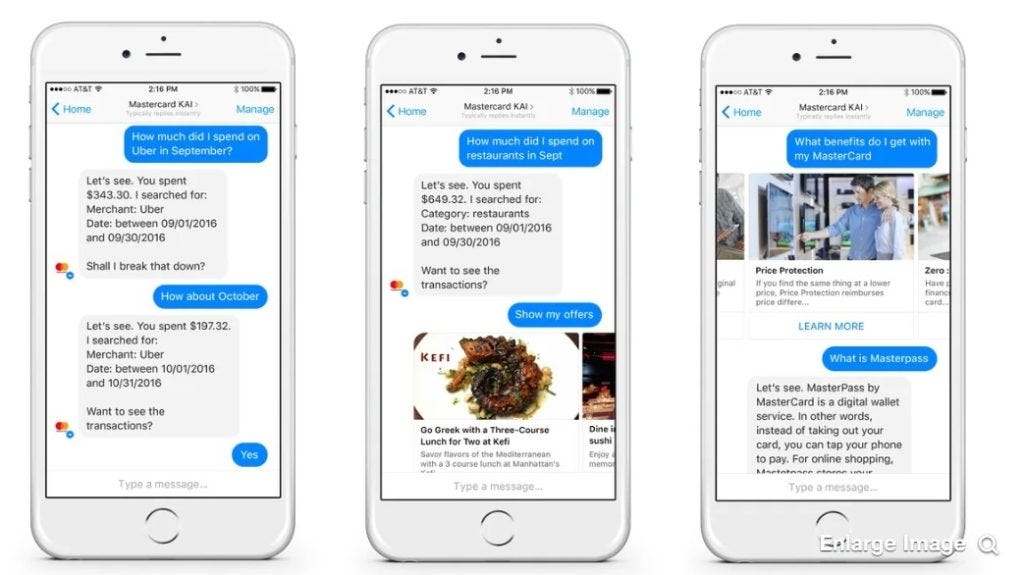
6. Personalization in Self Service
If you want to retain customers, personalization is the key, and chatbots are excellent at providing personalization at scale. Chatbots can leverage customer data and preferences, giving tailored, self-service experiences that give customers the power to resolve issues independently.
An ancillary benefit of chatbots providing personalized assistance is a real reduction in human agents’ workload, which will enable them to focus on more complex issues. These will be tasks that require human empathy and a high emotional quotient (EQ).
Capital One’s Eno chatbot gives personalized self-service assistance to customers based on their transaction history and account information. If a customer asks about a specific purchase, Eno can retrieve the transaction details and provide personalized guidance on disputing the change or requesting a refund.
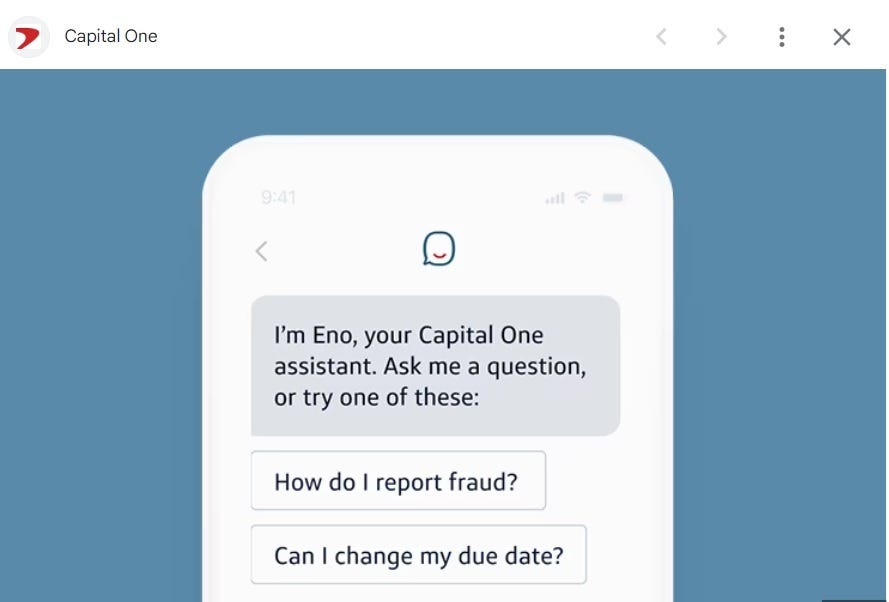
This level of personalization is impossible if you have a call center agent addressing hundreds of customers a day, and thus, a chatbot is an effective alternative.
7. Compliance and Quality Assurance
A lot of industries that employ call center agents are expected to deal with sensitive data on a daily basis, including the financial services and healthcare industries. These compliance and quality assurance capabilities can be built into chatbots, by which organizations can mitigate risks and maintain consistent service excellence.
Chatbots can be programmed to stick to specific rules and guidelines, automating compliance checks and providing real-time guidance to human agents. In a healthcare organization, for example, a chatbot can assist an agent to adhere to HIPAA regulations and best practices for handling sensitive patient information.
The chatbot can redact sensitive or Protected Health Information (PHI) and guide agents on appropriate language and procedures when discussing medical details.
A great example of a chatbot that is being put to use to help an organization with compliance is Prudential insurance’s chatbot, askPru. The chatbot is programmed with an excellent understanding of the underlying rules and regulations of the financial services industry, such as those related to data privacy or disclosure requirements.
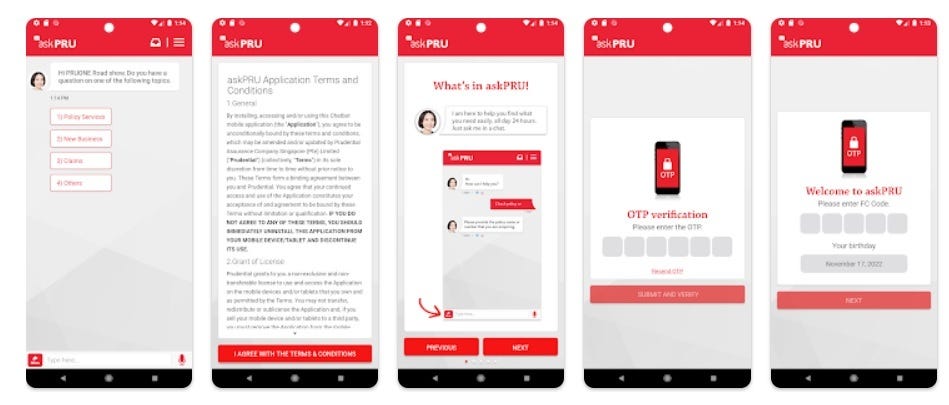
During conversations, the chatbot monitors each and every interaction and prompts the agents when it detects any potential violation. Customers are thus given the confidence that their conversations are handled in a secure, ethical and legally compliant way.
8. Predictive Analytics
Call centers traditionally have had a reactive approach, where customers reach out to the organization after they have encountered a problem. But with chatbot in call center, they can move from a reactive approach to a proactive approach, whereby it optimizes resource allocation, minimizes disruptions, and enhances the overall customer experience experience.
Chatbots can analyze historical data and identify patterns and trends, which will enable accurate forecasting and proactive planning. Chatbots can identify emerging issues or recurring customer pain points, addressing them promptly and improving customer satisfaction scores.
Predictive analytics is put into action by the chatbot that exists on Engie’s website. Engie is a leading energy company based out of France, and the Engie chatbot is equipped with advanced machine-learning capabilities.
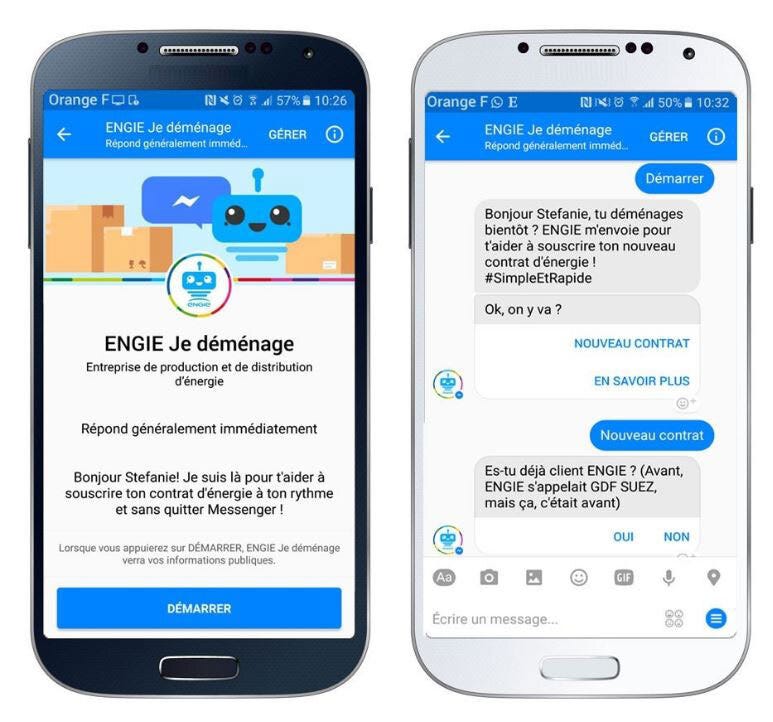
Engie’s chatbot analyzes millions of past customer conversations, inquiry types and resolution times. Using this data, the chatbot is able to predict future call volumes, peak periods and potential bottlenecks that may occur in customer service operations. This data-driven approach by Engie not only improves operational efficiency but also positions it as a forward-thinking, customer-centric entity.
9. Knowledge Sharing
Knowledge sharing is one of the key benefits of integrating a chatbot in call center operations. Chatbots are excellent at capturing and disseminating best practices, subject matter expertise, and creating a shared knowledge base that agents can access in real time.
Human agents can wade through this information super quickly, which allows them to quickly find relevant information, case studies, or expert insights that will address customer queries more efficiently. This type of collaborative approach not only reduces response times but also ensures that the support quality that the organization provides is top-notch.
Tata Consultancy Services (TCS), one of India’s biggest IT service providers, employed a chatbot designed to help in knowledge sharing across its network of customer support agents. The chatbot analyzes the conversation flow during customer conversations, identifies innovative communication strategies, and adds them to a centralized knowledge repository.
Chatbots thus foster a culture where agents learn from each other’s experience, leveraging collective expertise and providing more informed and effective support to customers.
10. Multilingual Support
Today, more and more customers prefer to get support in their own language, and hiring call center agents who speak multiple languages is just not feasible. For instance, this CSA research shows that more than 65% of the customers who purchased items online won’t do so if support is not available in their own language.
This is where chatbots step in. Chatbots can be trained to communicate in multiple languages, where users who are from different linguistic backgrounds receive assistance in their preferred language.
A good example of a multilingual chatbot is Vodafone’s conversational AI assistant, Amelia. Amelia is comfortable in over 100 languages, including regional dialects and colloquialisms.
This multilingual capability gives Vodafone the ability to provide consistent and localized support to customers across the globe.

Thus, call centers can leverage chatbots to break down language barriers and offer personalized support tailored to cultural nuances. This will help organizations create a truly inclusive and global customer experience.
Bringing It All Together
As you can see, chatbots can significantly enhance call center operations and unlock a world of opportunities for enhanced customer experiences, operational efficiencies, and business growth. Implementing chatbots can reduce customer service costs while improving customer satisfaction rates.
Make sure that you embrace this game-changing technology and position your call center as a forward-thinking, efficient organization that is capable of delivering exceptional customer service.
This blog was originally posted on kommunicate.io
Top 10 Benefits of Integrating a Chatbot in Call Center was originally published in Chatbots Life on Medium, where people are continuing the conversation by highlighting and responding to this story.
